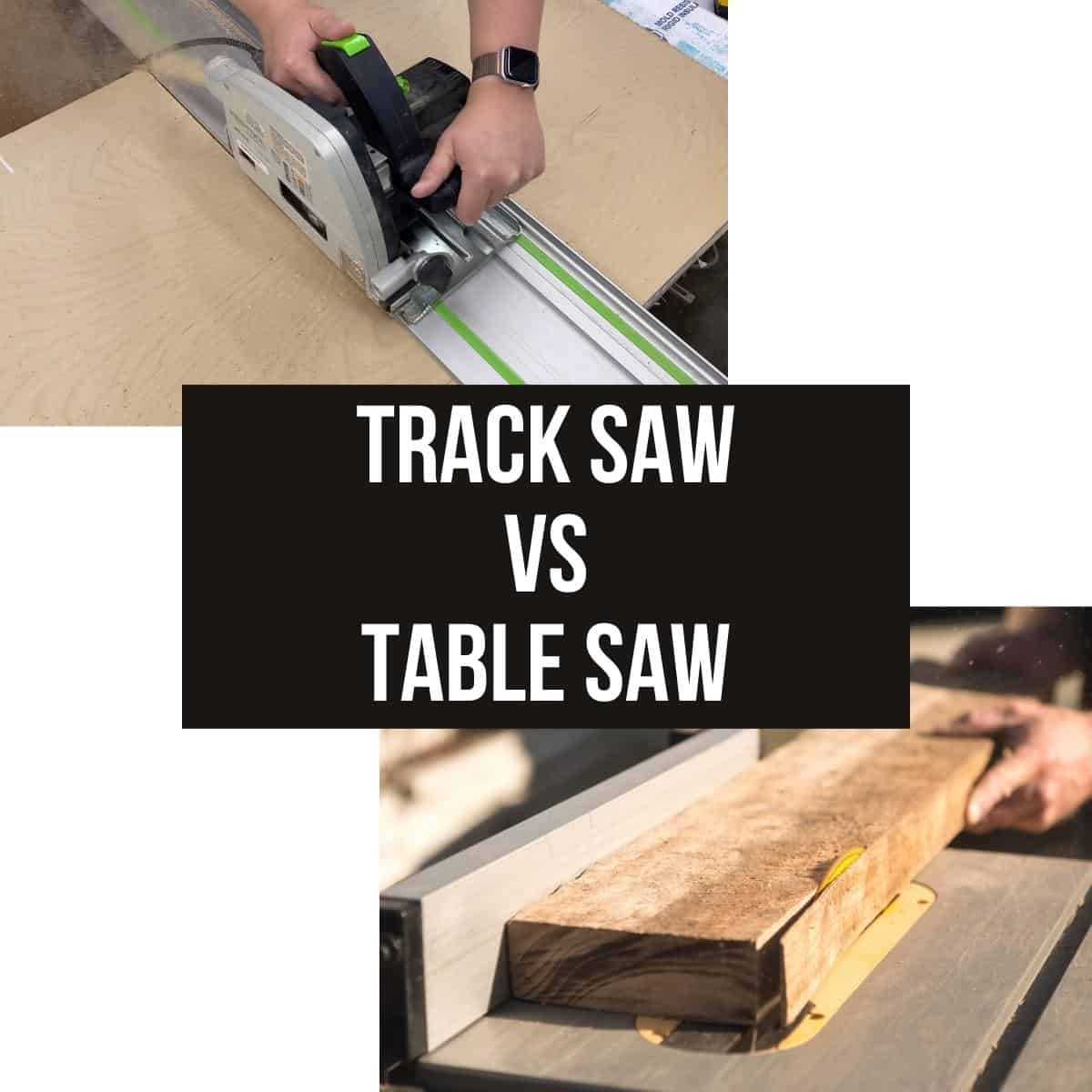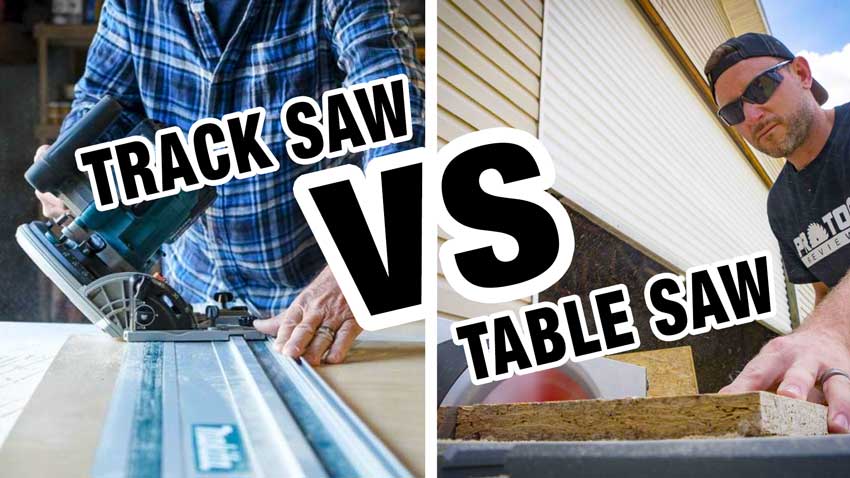When it comes to woodworking tools, it can be tough to decide which one is the champ. But today, we’re diving into the age-old debate: is a track saw better than a table saw? Strap in, because we’re about to break it down for you.
Picture this: you’re working on a project and need to make precise, long cuts. Enter the track saw, the heavyweight contender in the woodworking world. With its guide rail system, the track saw offers unparalleled accuracy and portability, making those long cuts a breeze.
But don’t count out the table saw just yet. This classic workhorse has been a staple in workshops for years. With its stationary design and powerful motor, the table saw is perfect for tackling large, heavy-duty jobs and ripping through thick materials like butter.
Now that you know the players in this showdown, it’s time to reveal the winner. So, grab a seat, because we’re about to reveal which tool reigns supreme in the battle of track saw versus table saw. Let’s get ready to rumble!

Is a Track Saw Better Than a Table Saw? Exploring the Differences
Both track saws and table saws are popular choices for woodworking projects, but which one is better? In this article, we will delve into the differences between track saws and table saws, examining the features, benefits, and applications of each. Whether you’re a professional woodworker or a DIY enthusiast, understanding the pros and cons of these tools will help you make an informed decision for your projects.
1. Track Saw: Portable Precision
A track saw, also known as a plunge saw, is a portable cutting tool that runs on a track or guide rail. It offers precise and straight cuts, making it ideal for tasks that require high accuracy, such as cutting plywood or creating clean, tight joints. With its ability to make plunge cuts, the track saw allows for versatility and flexibility in various woodworking applications.
One of the main advantages of a track saw is its portability. Unlike a table saw, which is a stationary tool, a track saw is lightweight and easy to transport. This makes it a great choice for job-site work or projects that require on-the-go cutting. The track system ensures stability and straight cuts, even when working with large pieces of material. Additionally, the track saw’s dust collection system helps maintain a cleaner work environment.
In summary, the track saw’s portability, precision, and versatility make it an excellent choice for carpenters, contractors, and DIYers who prioritize accuracy and need a tool that can easily be taken to different locations.
2. Table Saw: Power and Stability
The table saw is a staple in woodworking workshops, known for its power and stability. This stationary tool consists of a flat table with a circular saw blade protruding from the surface. It is primarily used for cutting large pieces of wood and making straight, repetitive cuts.
One of the significant advantages of a table saw is its power. It can handle heavy-duty cutting tasks with ease, making it suitable for professional use and large-scale projects. Additionally, the table saw offers stability, thanks to its solid base and large work surface. This ensures precise cutting and reduces the risk of accidents.
Another benefit of a table saw is its versatility. With various accessories and attachments available, you can customize your table saw to fit different applications, such as crosscutting, ripping, or creating intricate joinery. However, it’s important to note that due to its size and weight, a table saw is less portable than a track saw.
3. Comparing the Features: Track Saw vs. Table Saw
Now that we’ve explored the individual benefits of track saws and table saws, let’s compare their features side by side:
| Feature | Track Saw | Table Saw |
|---|---|---|
| Portability | High | Low |
| Precision | High | High |
| Power | Lower | Higher |
| Versatility | Medium | High |
| Stability | High | High |
| Dust Collection | Good | Varies |
Key Takeaways: Is a track saw better than a table saw?
- A table saw is better for making straight cuts quickly and accurately.
- A track saw offers more portability and flexibility for cutting large sheets of material.
- A track saw allows for guided cuts, reducing the risk of mistakes and accidents.
- A table saw is generally more powerful and can handle thicker materials.
- The choice between a track saw and a table saw depends on your specific needs and projects.
Frequently Asked Questions
If you’re wondering which is better between a track saw and a table saw, we’ve got you covered. Below are some commonly asked questions about these tools and their differences.
1. Can a track saw replace a table saw?
While a track saw and a table saw have different purposes, a track saw can indeed replace a table saw for certain tasks. Track saws are great for breaking down large sheets of material, making accurate cuts, and creating longer rip cuts. With the use of a guide rail, track saws offer precise results similar to table saws.
However, table saws excel at making repetitive crosscuts and precise angles, making them essential for heavy-duty woodworking projects. So, while a track saw can be a versatile tool, it may not fully replace the functionality of a table saw.
2. Which is safer to use, a track saw or a table saw?
Both track saws and table saws have their safety considerations, but with proper usage, they can be safe tools. Track saws typically have a lower risk of kickback, as the blade is enclosed within a cutting guard. Additionally, the cutting motion is controlled by the user, reducing the chances of accidents.
On the other hand, table saws may have a higher risk of kickback due to their exposed blade and powerful motor. However, with the right safety precautions, such as using push sticks and blade guards, and maintaining proper table saw etiquette, such as keeping a clear workspace and wearing safety gear, it is possible to use a table saw safely.
3. Can a track saw make bevel cuts like a table saw?
Yes, a track saw is capable of making bevel cuts, but the process is slightly different compared to a table saw. While table saws have an adjustable blade angle, track saws achieve bevel cuts using guide rails. By tilting the track saw against the guide rail, it is possible to make precise bevel cuts.
However, it’s worth noting that table saws often offer more versatility when it comes to bevel cuts, as they allow for tilt adjustments without the use of additional accessories or modifications.
4. Which is easier to transport, a track saw or a table saw?
When it comes to portability, track saws have an advantage over table saws. Track saws are generally lighter and more compact, making them easier to transport to job sites or different locations. With their guide rails and portable design, track saws offer flexibility and convenience in terms of transport.
Table saws, on the other hand, are typically heavier and bulkier, making them less portable. However, some table saw models come with folding stands or built-in wheels, which makes them more maneuverable and manageable during transportation.
5. Which tool is more suitable for beginners, a track saw or a table saw?
For beginners, a track saw may be a better option due to its ease of use and safety advantages. Track saws are more intuitive and user-friendly, with straightforward controls and a lower risk of kickback. They also provide accurate cuts, allowing beginners to achieve precise results without extensive woodworking experience.
Table saws, while versatile, can be more challenging for beginners due to their exposed blade and the need for proper technique to avoid accidents. However, with proper training, safety precautions, and practice, beginners can also become proficient in using table saws effectively.

Summary
So, to sum it up, a track saw and a table saw both have their own advantages.
The track saw is portable and great for making straight cuts on large sheets of material. However, the table saw offers more versatility and precision for other types of cuts.
In the end, it really depends on what you need it for and how much space you have.
If you’re mostly working on big projects and need to take your saw on the go, a track saw might be the better choice.
But if you have a dedicated workshop and need a saw that can handle a variety of tasks, a table saw is worth considering.
Hopefully, this article has helped you decide which saw is the right fit for you.
